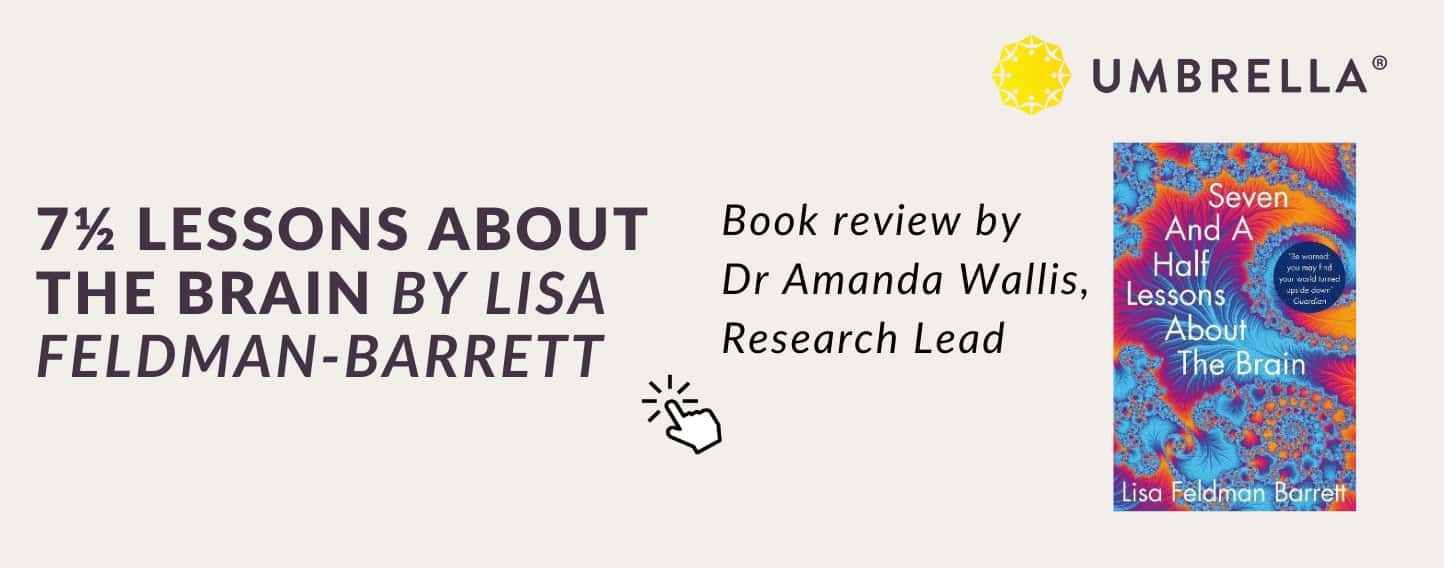As neuropsychologists and many others will already be aware, Lisa Feldman-Barrett is in the top 1% of most-cited scientists around the world for her work in psychology and neuroscience. She is affiliated with Northeastern University, Massachusetts General Hospital and Harvard Medical School.
Her most recent book, 7½ Lessons about the Brain, was published in 2020 and, at only 125 short pages, it is a surprisingly easy read for a book that seeks to disentangle some of the many myths and misconceptions around the human brain and how it works. Feldman-Barrett’s writing is split into seven (and one half) short, stand-alone essays on the current state of what we know about “how that three-pound blob between your ears makes you human” (as she puts it).
Written for a general audience, her writing is thought-provoking, topical, and rigorously backed up with research (all of which is publicly accessible on her meticulously organised website with a complete, and easily navigable, reference list). I particularly appreciate the author’s nuanced approach to discussing ideas that may have not yet reached scientific consensus, and her explicit efforts to identify where she is making assumptions in her writing or using metaphors to illustrate how parts of the brain works.
Her unambiguous approach towards using such metaphors felt particularly necessary, given that large chunks of this book were devoted to dispelling common myths about the brain – many of which originated from metaphors that audiences had mistakenly morphed into fact. For example, Feldman-Barrett dispels the ideas of there being a literal left side of the brain for logic and a right side for creativity, that the brain “lights up” with activity, or that there are three key parts to our brain – the thinking/rational brain, the emotional brain, and the lizard/survival brain.
Dispelling the latter myth – of our having three brains, otherwise known as the “triune brain” idea – was one of the more interesting parts of the book from my perspective. As noted by Feldman-Barrett, “The triune brain idea is one of the most successful and widespread errors in all of science.” She uses the example of eating chocolate cake as an example of how alluring this myth is for us to believe. We want to believe that it is our instinctual “lizard brain” that lures us towards eating such a calorie-dense food, for example, and that our emotional limbic system backs this behaviour up with anticipation of the reward. This lends itself to a nicely digestible argument that our superior rational “thinking brain” is what holds us back from indulging.
In fact, as Feldman-Barrett explains over the course of one essay, we have only one brain – not three – and the reason why the triune brain idea has persisted for so long may be, in part, due to our attachment to the idea that thinking is rational whereas emotion is not. But, as noted by Feldman-Barrett in one example, “…feeling distressed is not evidence of being irrational or that your so-called emotional brain has hijacked your supposed rational brain. Distress can be evidence that your whole brain is expending resources towards an anticipated payoff.” I believe that many of us as psychologists may benefit from understanding (or re-acquainting ourselves with) the science on this topic.
In her remaining essays, Feldman-Barrett covers topics ranging from how infant human brains develop to how our brains shape our reality. Her essay on how our brain is interdependent with other people’s brains was particularly refreshing, in that it took a more integrated, rather than individualistic, approach to thinking about our bodies. As Hamley and Le Grice noted in their article on identity, indigeneity, and wellbeing in young Māori men last year (2021), “A common characteristic of Western thinking is a tendency to reduce broader systems into smaller and smaller parts (Durie, 1998). By contrast, Māori ways of being centre on relationality, and integration into broader systems.” From this perspective, I appreciated this book’s discussion on how our nervous systems do not just work in service of our own needs but also the needs of others around us. The author therefore reminds us to be mindful of ways that we can act to help, not harm, the health of those around us through helping to regulate their “body budgets”. She also calls for readers to consider the wider implications of a brain that is chronically stressed (by illness, financial hardship, discrimination, or any other combination of challenges), and how these effects play out at large in terms of population health, education, innovation, and frayed social connections.
Taken altogether, 7½ Lessons about the Brain is an intriguing and bite-sized summary of recent research and emerging theories on how our brain has evolved, how it functions, and what that means for how we think, behave, and interact with others at an individual, community, and societal level. For those who want to dive deeper into the essays and their arguments, consult the book’s appendix, titled “The Science Behind the Science”, or its accompanying reference-list-meets-website (which you can find at www.sevenandahalflessons.com).



